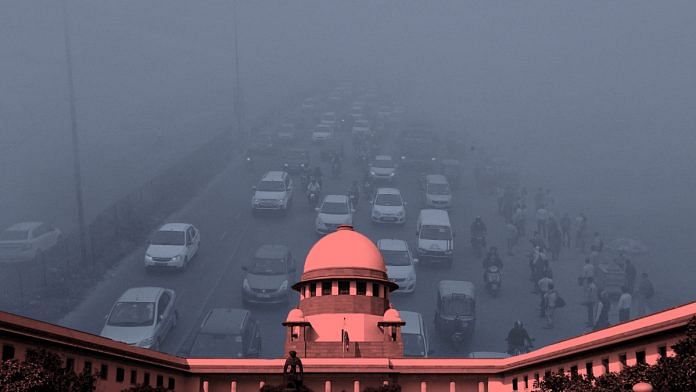The environment pollution prevention and control authority (EPCA) appointed by the Supreme Court has suggested a ban on all non-CNG vehicles on Delhi roads on days with high air pollution owing to the increased smog post-Diwali.
ThePrint asks– SC panel wants non-CNG vehicles banned on Delhi’s smog days: Practical or knee-jerk idea?
Wonder if SC panel did the math before suggesting laughable ban on non-CNG vehicles
 Devalina Kohli
Devalina Kohli
Member, SaveDelhiSOS and MyRightToBreathe
In its supreme wisdom, the SC-appointed panel of the EPCA has suggested that all non- CNG vehicles be banned on bad air days in Delhi. If there ever was a stupid knee-jerk reaction to the issue of Delhi’s air pollution, this is up there on the list.
Why? Let’s look at some figures (from the Delhi Transport site). In May 2018, Delhi had a total of 1,05,67,712 vehicles. A few thousand must’ve been added to it by now. Of these, we have, say, 51,000 cars plying in Delhi every day. The transport department does not give any information on how many of these are CNG privately owned cars.
Now, it also tells us that there were 1.98 lakh auto rickshaws and 91,000 taxis in 2015-16. Let us assume that these are all in fit condition to ply and there is no surge pricing.
We are looking at 1.5 crore vehicles in use in Delhi, of which only 3.8 lakh are CNG (plus a few thousand more of privately-owned cars). How is the population of Delhi to move – for work, shop, school, college, or any activities – if these vehicles are banned? Metro does not have last mile connectivity in most places. Buses are usually jam-packed. Women have a tough time anyhow with autos and taxis. There are not enough CNG filling stations. The problems are immense. I wonder if ‘they’, in their wisdom, have done the math.
This is like the recent knee-jerk ban on crackers. Or do they believe that the best answers are always last minute, hastily decided, tardily implemented?
Why is there no long-term plan, like in the case of Beijing, which brought down pollution over five years in a graded manner? Every year we go over the same problems and every year the ingenuity of some bright spark provides laughable solutions. And we, the citizens of Delhi, suffer.
Ban idea is shortsighted but may be necessary to push people out of apathy
 Barun Aggarwal
Barun Aggarwal
Co-founder, Care for air
This seems to be, at the surface, a knee-jerk reaction because the SC panel has not considered the following:
1. Alternate modes of transport are not available (our public transport system is already over-burdened and we need at least another 10,000 buses in Delhi alone)
2. This does not affect 2-wheelers, which constitute a major chunk of vehicular pollution.
However, maybe, we need to inconvenience an entire population and shut down the city and economy by keeping all cars off the streets since our public transport infrastructure won’t be able to handle the stress, before our powers that be wake up to taking long-term planned solutions into consideration.
The real issue is that of lowering emissions at source. And a clear, multi-pronged approach with a long-term action plan is required that will need a longer-term political horizon and will. The right agency is also required that is well-empowered or reconstituted to make this happen. But at CFA, we still welcome it as it has the potential to build further awareness and push people out of their apathy and comfort zone to do what REALLY needs to be done to clean our air.
As a true solution, it is reactive and shortsighted. But alas, may be that shock to the system will be necessary for us to do anything for ourselves.
Also read: Odd or even, data shows road rationing just not effective
Move could create divide between occupational needs and environmental requirements
 Kanchi Kohli
Kanchi Kohli
Researcher, Centre for Policy Research
First, we must understand that emergency situations such as these require very strong actions from authorities. That being said, if this ban on all non-CNG vehicles is implemented, it will likely isolate the citizens of the city.
This is a far greater issue pertaining to the traffic conditions in the capital and the sheer lack of pedestrian space. These are times of emergency, but the move could cause immense inconvenience to the citizens. While inconvenience is sometime unavoidable, this could’ve been thought of well in advance.
We have been waiting for the EPCA to do something about the pollution dangers since October. They were in a position to bring about much more gradual and smooth changes throughout the year. The way to do that would be to engage the citizens of NCR in whatever changes they were planning, well ahead of time. Trying to persuade the citizens by suggesting a potentially good idea and giving it more time to be accepted would’ve been a much smarter move.
However, this suggestion may seem like a top-down approach and thus, will not be easily accepted. Let’s not forget, CNG vehicles are far fewer in number than non-CNG vehicles on NCR roads. So, this isn’t just about inconveniencing the elite, because a large section of non-elites also depend on petrol and diesel vehicles. Hence, this move could create a divide between the occupational needs of the citizens and the environmental requirements. We don’t need moves which divide, we need moves which unite.
Vehicular ban is of utmost necessity to reduce emissions
 Sandhya Ramesh
Sandhya Ramesh
Associate editor (science), ThePrint
This emergency reaction might look like a knee-jerk response, but it still is important and necessary. At this point, any suggestion that curbs emission is important and necessary, given the state of the region.
Several contributors are still active or have airborne residue in the regions of NCR and north India, such as smoke from stubble burning, vehicle emissions, and of course, post-Diwali smoke. All of these are major particulate contributors to pollution and only aggravate an already choked city.
Vehicular emission is one of the biggest contributors to pollution in the busy NCR region, and the popular LPG fuel emits high amounts of greenhouse gases. As an alternative to LPG, CNG emits minimal greenhouse gases. This kind of curbing on emissions should actually be performed fairly regularly in the capital to bring down the overall levels of pollution.
It is unfortunate that due to other unavoidable reasons, the same task force the recommendation has been made to has actually relaxed the ban on construction as well as allowed trucks in the city of Delhi. Both are major contributors to particulate dust matter that are harmful to health. The task force also plans to relax the ban on industries using coal and biomass. All of these contribute to increasing emissions again in the region. Therefore, this measure, even if minimal, is of utmost necessity to be able to reduce emissions as much as possible.
By Fatima Khan, journalist at ThePrint. You can follow her on twitter @khanthefatima.




As far as the vehicles are concerned the required pollution certificate is not imminent but strict control of smoke emission. I have seen people having certificates but thick fog type of smoke goes frequently from many vehicles. Police just check the certificate and take no action. This attitude is ridiculous.